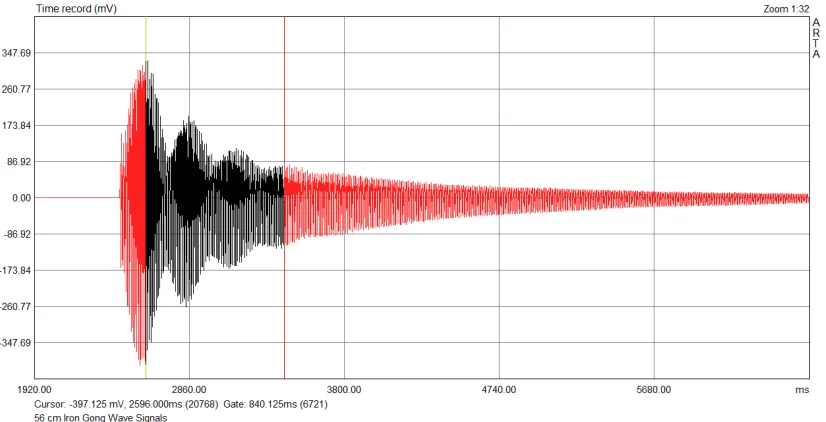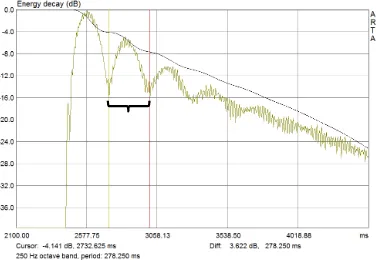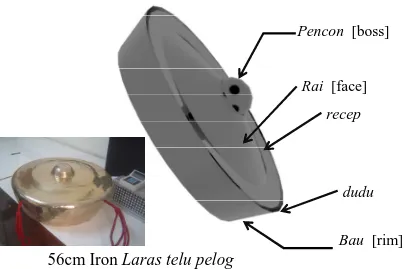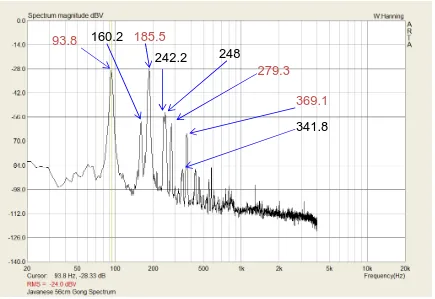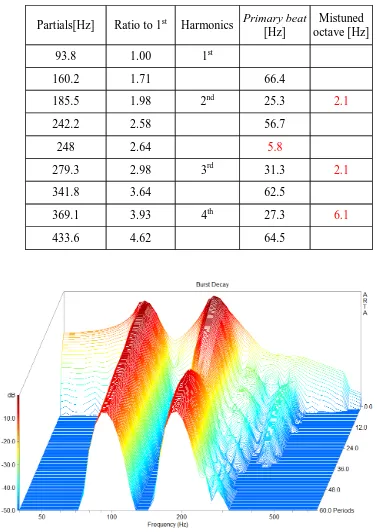Javanese Gong Wave Signals
Matias H.W. Budhiantho1 and Gunawan Dewantoro2
Department of Electronic and Computer Engineering1,2
ensemble of predominantly struck instruments that has deep philosophical meaning for Javanese. However, there lack of studies concerning on this particular instrument as a bridging means between scientific description and human artistic perception. This study aims to investigate the spectral and temporal properties as well as particularly look into the typical wave-like sound of the Gong. Acoustic measurements were conducted and analyzed using ARTA. Both frequency and time domain signals were explored to better understand the nature of the Gong wave signals. The fundamental frequency which decays much more slowly than the other harmonic started with lower increasing frequency. The wave-like sound of the Gong due to signal behavior that resemblance the primary and secondary mistuned octave beats phenomenon between early and later development of the fundamental and second third mistuned harmonic partials frequency.
INTRODUCTION
Sound of Javanese Gong plays an important role in Javanese culture. In gamelan music orchestra, gong sound instructs, marks and ends certain parts of a gamelan composition [1]. The gong sound is also used to declare the opening and closing of important religious and secular events or various rituals. The roaring wavelike sound of the gong is associated by Javanese with Bima’s giggle that creates grandeur yet calming feeling. Bima is known as bold but honest and just hero, a great legend in Javanese puppet shadow (wayang) story. The wavelike sound repetition cycle of a best sounding gong can be as 12 to 13 as many. A gong that can not produce wavelike sound is considered can only howling [2].
A Gong is still traditionally handmade by casting, hammering, forging and tuning as well. Large gong crafting almost a lost art before it was revived in the 60’s [3].
INVESTIGATION APPROACHES AND MEASUREMENTS
We conducted our investigation both in time and frequency domains and 3D signal burst decay as well by using ARTAi PC based software. We applied an external impulse signal by hitting the boss at the center of the gong. The gong sound was recorded by near field measurement from behind the boss of the gong. Based on the measured impulse response we obtained and analyzed the gong wave signals.
Gong Wave Signal Waveforms
Repeated measurements of our iron Gong Kempul consistently produced impulse response as shown in Figure 1. We can see clearly that during the less than 2 seconds there are at least four peaks of signal envelope with an average interval of 280 ms that relates to 3.5 Hz signal fluctuation.
We looked further into repetition period of the gong signal waveforms. The repetition period of signal shows variation between 10.500 ms to 10.750 ms from initial – mid – tail part of signal as depicted in Figure 2. This shows that there is time signal frequency fluctuation between 95.2 and 93.0 Hz. This frequency fluctuation probably a transient processes from impulse excitation to free decaying vibration of the gong. The frequency difference of 2.2 Hz may produce perceptible beating sound [5]-[7].
Figure 1. The sound last more than 4s, with apparent fluctuation period of 280 ms or frequency of 3.5 Hz
i
Figure 2. Identified repetition frequencies: highest 95.2 Hz, lowest 93.0 Hz, frequency difference: 2.2 Hz, another possible origin of beat.
Figure 3. The beat period are apparent for about 278.250 ms, giving a beat frequency of 3.5 Hz
Signal energy decay fluctuation in Figure 3 again shows fluctuation of approximately 3.5 Hz in agreement with the time signal envelope.
GONG WAVE SIGNAL SPECTRUM
There are terms [not all given here] to indicate various parts of a Javanese Gong, as indicated in Figure 4. The terms are used to specify measurements and processes for instructing workers in manufacturing the gong. However, Finite Element Analysis [8] predicted that gong shape affects the spectrum of the gong.
Gong tuning starts by specifying weight and mixture of the material (tin, brass or iron). A gong requires different specific mixture (tin, brass, iron) and weight for a certain pitch (laras) and size of the gong. Various authors has been investigated that Gong pencon (boss) and bau (rim) size arrange partial frequencies to be more harmonically related [8]. Fine tuning is done by filling and hammering various parts of the gong to lower its pitch to target one [9,5].
Figure 4. Javanese Gong Smith’s Terms and Anatomy
A gong with correct laras produces many partials with harmonic and inharmonic frequencies. The slowly decaying sound of the gong open the possibility of those partials to interfere that result in various beats. There are two kinds of prominent beats, i.e. primary and
Pencon [boss]
recep
dudu
Bau [rim]
Rai [face]
second–order or secondary beats. The primary beats occur between closely existing partial in the spectrum, while the secondary beats occur between a tone and its mistuned harmonics [10].
When there are two discrete tones with frequency f2 higher than f1 and n is integer
number, then those two tones will produce a beat frequency of f. For n = 1, we obtain primary
beat, for n>1 we obtain second-order or mistuned harmonic beats. Since, if f2 = n f1 we got exact
harmonically related tones.
Primary Beat f2 = f1 + f (1)
Second-order mistuned harmonic beats f2 = nf1 + f (2)
Beat is perceptible as a fluctuating sound if its frequency is less than 10 Hz [6]. And, in the case of this Gong Kempul, since the gong sound become very weak after 3s, The perceptible beat frequency can not be lower than 0.3 Hz. We measured many times and obtained up to 9 consistent partials of the Gong Kempul, as depicted in Figure 5. Red numbers indicate frequencies of almost harmonic partials.
Figure 5. Gong Kempul partials and harmonics.
Table 1 shows the 9 partials of the gong with 4 slightly mistuned harmonics. We found one primary beat and 3 secondary mistuned harmonics. The primary beat and secondary beats
93.8 160.2 185.5
242.2 248
279.3
369.1
resulted in further frequency difference of 3.7 - 4 Hz in good agreement with the gong acoustic signal envelope.
Table 1. Primary and Secondary Mistuned Octave Beats
Partials[Hz] Ratio to 1st Harmonics Primary beat [Hz]
Mistuned octave [Hz]
93.8 1.00 1st
160.2 1.71 66.4
185.5 1.98 2nd 25.3 2.1
242.2 2.58 56.7
248 2.64 5.8
279.3 2.98 3rd 31.3 2.1
341.8 3.64 62.5
369.1 3.93 4th 27.3 6.1
433.6 4.62 64.5
The 3D burst decay in Figure 6 clearly showed that the mistuned secondary 2nd harmonics beat of 2.1 Hz and primary beat of 5.8 Hz can be seen from of the gong wave signal. It can also be seen that the mistuned 2nd harmonic beat was more dominant than the primary beat. The mistuned 4th harmonic is 40 dB below the fundamental. It may results in further beat of 0.3 Hz (3s period) but decayed signal causing it imperceptible. However, we still could not be certain that the wavelike sound of the gong come from the secondary mistuned harmonic beat or beat from further frequency difference resulted from the interaction (heterodyning process) of the primary and secondary beat [5] shown by signal energy decay curve of Figure 1 and Figure 3.
CONCLUSIONS
The 56 cm Gong Kempul has a nature of harmonicity with fundamental frequency at 93.8 Hz. The second, third, and fourth harmonics are, respectively, at 185.5 Hz, 279.3, and 369.1 Hz. The wave-like sound of the Gong Kempul may be traced to the primary beat and secondary mistuned 2nd harmonics beats. The primary beat of 5.8 Hz and secondary mistuned 2nd and 3rd harmonics of 2.1 Hz together produce further beat of 3.7 - 3.8 Hz that is in a close agreement with the fluctuation frequency of the signal envelope and the energy decay curve. The mistuned 4th harmonic is 40 dB below the fundamental. It may results in further beat of 0.3 Hz, (3s period) but decayed signal causing it imperceptible.
REFERENCES
1
B. Palgunadi, Serat Kandha Karawiran Jawi, Bandung: Penerbit ITB, 2002.
2
Proyek Inventarisasi dan Dokumentasi Kebudayaan Daerah, Ensiklopedi Musik Indonesia: seri
F-J, Jakarta: Departemen Pendidikan dan Kebudayaan, 1985, pp. 85-86.
3
N. Sorrell, A Guide to The Gamelan. Oregon, Portland: Amadeus Press, 1990, pp.44.
4
K.M. Hood, Music of The Roaring Sea: The Evolution of Javanese Gamelan, Wilhelmshaven: Heinrichshofen, 1980
5
A. H. Benade, Fundamentals of Musical Acoustics, 2nd ed., Dover Publications, 1990, pp. 135- 140.
6
B. Truax, Handbook for Acoustic Ecology, 2nd ed., Cambridge Street Publishing, 1999.
7
D. E. Hall, Musical Acoustics, 3rd Ed., Brooks/Cole, 2002.
8
McLachlan, “Finite Element Analysis and Gong Acoustics”, Acoustics Australia, 25(3), pp. 103-107, (1977)
9
Personal communication with Agung Kuncoro, Wirun gamelan village, Surakarta, Indonesia, 2013.
10
